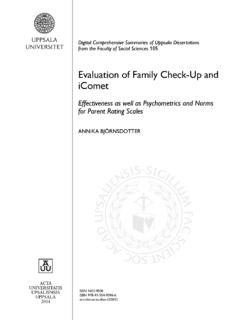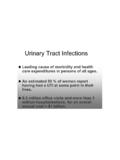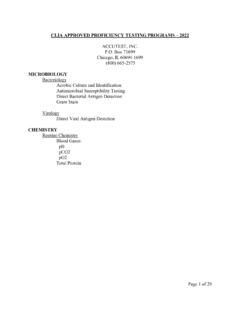Transcription of Aspects of Bacterial Resistance to Silver
1 ACTAUNIVERSITATISUPSALIENSISUPPSALA2015 Digital Comprehensive Summaries of Uppsala Dissertationsfrom the Faculty of Medicine 1084 Aspects of Bacterial Resistance to SilverSUSANNE S TTERLINISSN 1651-6206 ISBN 978-91-554-9205-2urn:nbn:se:uu:diva-2474 72 Dissertation presented at Uppsala University to be publicly examined in H rsal, Departmentof clinical microbiology, Dag Hammarskj lds v g 17, Uppsala, Friday, 8 May 2015 at13:00 for the degree of Doctor of Philosophy (Faculty of Medicine). The examination willbe conducted in Swedish. Faculty examiner: Professor Roland M llby (Institutionen formikrobiologi, tum r- och cellbiologi, Karolinska institutet).AbstractS tterlin, S. 2015. Aspects of Bacterial Resistance to Silver . Digital ComprehensiveSummaries of Uppsala Dissertations from the Faculty of Medicine 1084. 64 pp. Uppsala: ActaUniversitatis Upsaliensis. ISBN Resistance to antibiotics has increased rapidly within recent years, and it has becomea serious threat to public health.
2 Infections caused by multi-drug resistant bacteria entail highermorbidity, mortality, and a burden to health care systems. The use of biocides, including silvercompounds, may affect the Resistance to both biocides and antibiotics and, thereby, can be adriving factor in this aim of the following thesis was to investigate the frequency of Silver Resistance andthe effects of Silver exposure on Bacterial populations being of clinical significance and fromgeographically different parts of the world. Furthermore, it explored the genetic background ofsilver Resistance , and if Silver could select directly or indirectly for antibiotic a range of methods, from culture in broth to whole genome sequencing, bacterialpopulations from humans, birds and from the environment were studies showed that sil genes, encoding Silver Resistance , occurred at a high genes were found in 48 % of Enterobacter spp., in 41 % of Klebsiella spp.
3 And in 21 %of all human Escherichia coli isolates with production of certain types of extended-spectrumbeta-lactamases (CTX-M-14 and CTX-M-15). In contrast, Silver Resistance was not found inbird isolates or in Bacterial species, such as Pseudomonas aeruginosa and Legionella spp., withwet environments as their natural habitat. One Silver -resistant Enterobacter cloacae strain wasisolated from a chronic leg ulcer after only three weeks of treatment with Silver -based in-vivo effects of these dressings were limited, and they failed to eradicate both Gram-positive and Gram-negative bacteria. The activity of Silver nitrate in vitro was bacteriostaticon Gram-positive species such as S. aureus and bactericidal on Gram-negative species. InEnterobacteriaceae, sil genes were associated with Silver Resistance phenotypes in all but onecase. Using whole genome sequencing, single nucleotide polymorphisms in the silS gene werediscovered after Silver exposure in isolates with expressed Silver Resistance .
4 This resistancecould co-select for Resistance to beta-lactams, co-trimoxazole and findings of this thesis indicate that Silver exposure may cause phenotypic silverresistance, and it may reduce the susceptibility to mainly beta-lactams and select for bacteriawith Resistance to clinically important : Antimicrobial Resistance , Silver resistanceSusanne S tterlin, Department of Medical Sciences, Clinical Microbiology and InfectiousMedicine, Akademiska sjukhuset, Uppsala University, SE-75185 Uppsala, Sweden. Susanne S tterlin 2015 ISSN 1651-6206 ISBN 978-91-554-9205-2urn:nbn:se:uu:diva-2474 72 ( :nbn:se:uu:diva-247472) To my family List of Papers This thesis is based on the following papers which are referred to in the text by their Roman numerals. I S tterlin, S., Tano E., Bergsten, A., Tallberg, , Melhus, . (2012) Effects of Silver -based wound dressings on the Bacterial flora in chronic leg ulcers and its susceptibility in vitro to Silver .
5 Acta Dermato-Venerologica, 92: 34 39. II S tterlin, S., Edquist, P., Sandegren, L., Adler, M., T ngd n, T., Drobni, M., Olsen, B., Melhus, . (2014) Silver Resistance genes are overrepresented among Escherichia coli isolates with CTX-M pro-duction. Applied and Environmental Microbiology, 80 (22): 6863 69. III S tterlin, S. and Yin, H., Zhang, , Li, , Sun, , Melhus, . (2015) High carriage rate of CTX-M-producing Escherichia coli in Chinese preschool children. Submitted manuscript. IV S tterlin, S., Dahl , M., Tellgren-Roth, C., Melhus, . (2015) High frequency of Silver Resistance in invasive isolates belonging to genera Klebsiella and Enterobacter. Manuscript. Reprints were made with the permission by the respective publishers. Contents Preface .. 11 Introduction .. 13 Bacteria of interest and the infections they can cause .. 13 The Enterobacteriaceae family .. 13 Primary wound pathogens.
6 15 Environmental bacteria .. 15 Antimicrobial Resistance .. 16 Antimicrobial Resistance due to global response systems .. 16 Antimicrobial Resistance due to genetic exchange .. 17 Circulation of resistant Bacterial clones .. 18 Lack of One Health perspective on antibiotic Resistance .. 19 The success story of CTX-M-producing Enterobacteriaceae .. 21 Silver .. 22 Role of Silver in human medicine .. 22 Antibacterial activity of Silver .. 23 Bacterial Resistance to Silver .. 23 Risks associated with the use of Silver .. 25 Co-selection of antibiotic and heavy metal Resistance .. 25 Cross- Resistance .. 25 Co- Resistance .. 26 Co-regulation .. 27 Aims of this Doctoral Thesis .. 28 Materials and Methods .. 29 Bacteria .. 29 Silver Resistance .. 31 Susceptibility testing to Silver nitrate .. 31 Exposure of bacteria to Silver in vitro .. 31 Growth curves .. 31 Detection of genes in the sil operon.
7 32 Sanger sequencing of the silS gene .. 32 Next generation sequencing .. 32 Antibiotic Resistance .. 32 Antibiotic susceptibility testing .. 32 Amplification and characterisation of Resistance genes .. 33 Outer membrane protein profiles .. 33 Epidemiological typing .. 33 PCR-based fingerprinting .. 33 MLST .. 33 PCR-detection of the O25b-ST131 clone .. 34 Clonality with BURST .. 34 Statistical analyses .. 34 Results .. 35 Antibacterial activity of Silver .. 35 Antibacterial activity of Silver in vivo (I) .. 35 Silver nitrate MICs and MBCs .. 36 Frequency of Silver Resistance .. 37 Frequency of phenotypical Resistance to Silver nitrate .. 37 Genetic Resistance to Silver .. 37 The sil operon and phenotypic Silver Resistance .. 40 Sil genes and phenotypic Resistance to Silver nitrate .. 40 Fitness of Silver -resistant strains .. 40 SNPs in the silS gene .. 41 Co-selection of antibiotics and Silver .
8 42 Co-selection in isolates without in-vitro exposure to Silver .. 42 Co-selection in isolates with in-vitro Silver Resistance .. 42 Effect on outer membrane proteins .. 43 Association of sil genes and CTX M production in E. coli .. 43 Association of sil genes and antibiotics .. 44 Association of sil genes and merA genes .. 44 Discussion .. 45 Antibacterial effects of Silver .. 45 Distribution of Silver Resistance .. 46 Genetic background to Silver Resistance .. 48 Co-selection of antibiotic and Silver Resistance .. 48 Conclusions .. 50 Sammanfattning p svenska .. 51 Acknowledgements .. 53 References .. 55 Abbreviations ESBL Extended spectrum beta-lactamase MIC Minimal inhibition concentration MBC Minimal bactericidal concentration cfu Colony forming unit SNP Single nucleotide polymorphism AP-PCR Arbitrarily-primed polymerase chain reaction MLST Multi locus sequence typing ST Sequence type TEM Temoniera beta-lactamase SHV Sulfhydryl variable beta-lactamase CTX-M Cefotaximase-Munich beta-lactamase BURST Based upon related sequence type Omp Outer membrane protein MRSA Methicillin-resistant Staphylococcus aureus 11 Preface Among the most commonly prescribed drugs, antibiotics are undoubtedly the number one.
9 We use them for a wide range of Bacterial infections, from quite simple forms with high spontaneous recovery rates to life-threatening conditions with no chance of survival without antibiotic treatment. Antibiot-ics are a prerequisite to more advanced medicine, including transplantations and oncologic treatments. Their use, overuse and misuse have, however, brought us rapidly closer to the post-antibiotic era, with antibiotic Resistance having become one of the greatest challenges in modern medicine. Ever since their introduction, the incidence of Bacterial Resistance to anti -biotics has continuously increased. The result of this evolution is a higher frequency of treatment failure, prolonged hospitalisation periods and higher morbidity and mortality rates. The decreased effectiveness of pre-operative antibiotic prophylaxis and an increased need for combination antimicrobial chemotherapy in advanced intensive care have also caused a cost explosion for health care systems.
10 Even though we have not yet reached the post-antibiotic era, we are just getting its first foretaste. About 25,000 patients die every year in Europe as a result of infections caused by resistant bacteria, and both national and inter-national surveillance programs are facing an exponential growth in the inci-dence of multi-drug Resistance in most human Bacterial pathogens. As a consequence of the development described above, local, national and global initiatives have been taken to combat antibiotic Resistance . Two main targets have been identified: Lowering the consumption of antibiotics and reduction of the dissemination of resistant bacteria by providing better infection control. There is broad approach to this with a One Health perspec-tive, with humans, animals and the environment thereby being considered in the same way. An example of how this can work is that both human and veterinary care personnel should be encouraged to use antibiotics under stricter and more rational Aspects , and that access to antibiotics by non-health care professionals must be restricted.














